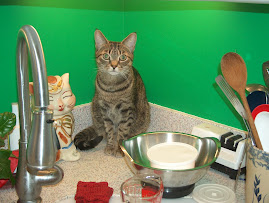 Lard is one of the easiest things one can make. Here is my tutorial, drawn from multiple sources and with pictures. I don't have a picture of the bag of frozen leaf lard, but it started out at just under 3 lbs. Leaf lard is the fat lining the abdomen and kidneys in a pig. You can render from belly fat, too, but traditionally "lard" refers to leaf lard fat, and that's how I've always made it.
Lard is one of the easiest things one can make. Here is my tutorial, drawn from multiple sources and with pictures. I don't have a picture of the bag of frozen leaf lard, but it started out at just under 3 lbs. Leaf lard is the fat lining the abdomen and kidneys in a pig. You can render from belly fat, too, but traditionally "lard" refers to leaf lard fat, and that's how I've always made it.My approach to lard has become very simple. The trick, for me, has been not worrying if it takes a long time, and embracing the whole food approach - so that I'm not obsessively trying to render every last little bit of fat out of the lard. If the approach appeals to you and you can put the leftovers to good use (see the Eating Notes at the end of the post), this recipe is for you.
Recipe:
Rendered Leaf Lard
Leaf lard
Put the lard in a heavy pot.
 Put in an oven set at 225F. Cook, gently stirring every now and again.
Put in an oven set at 225F. Cook, gently stirring every now and again. Cook until the solid pieces are floating. Take the pot out and mash the lard with a potato masher. Put the pot back in for another hour and repeat. picture above shows the lard just before mashed the last time.
Cook until the solid pieces are floating. Take the pot out and mash the lard with a potato masher. Put the pot back in for another hour and repeat. picture above shows the lard just before mashed the last time.After an hour after the final mashing, remove the pot from the oven. Increase heat to 425.
Strain the big solid pieces out and put on a rack over a pan. Cook about 20 minutes or until nicely browned but has not started smoking. Note that they look a bit like bacon, but there's basically nothing there but fat and they will crumble apart if any force is applied.
 Remove the rack after the solid pieces have stopped dripping. Strain the lard from the pot and the pan under the rack (assuming it has not smoked - otherwise, use it for something else) through a fine cheesecloth into a container to chill. Reserve the chunks, pieces, and strained bits.
Remove the rack after the solid pieces have stopped dripping. Strain the lard from the pot and the pan under the rack (assuming it has not smoked - otherwise, use it for something else) through a fine cheesecloth into a container to chill. Reserve the chunks, pieces, and strained bits. Eating notes: Lard is great - it makes pastries really crumbly and fluffy and enhances the taste of fried foods without imparting a strong flavor of its own.
Eating notes: Lard is great - it makes pastries really crumbly and fluffy and enhances the taste of fried foods without imparting a strong flavor of its own.The solids are equally good in other uses. Suggestions: Crumbled into a hot salad dressing recipe; Fry up a little bit and then spread around and start an omelet; saute with mushrooms; put into an egg pie . Anything where a little bacon fat would do or where you just want something a little unexpected and good is a candidate. I put the "crispier" bits in one plastic zippy bag and the solids left over from the straining in another. They both go in the freezer and I call on them as needed. Invariably, the solids are used up before the lard is.




No comments:
Post a Comment